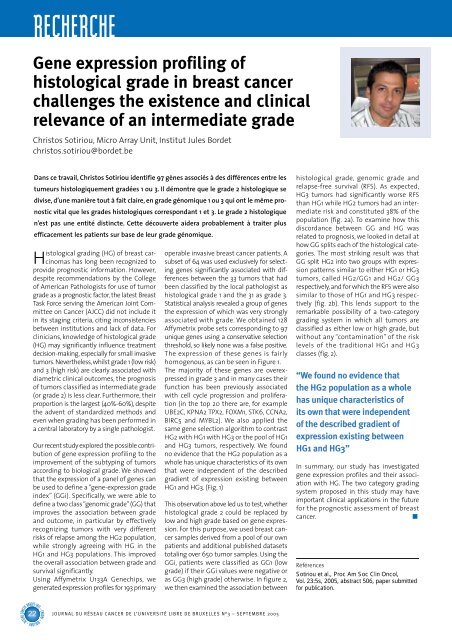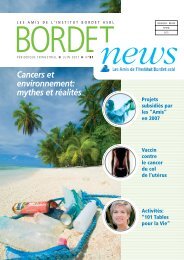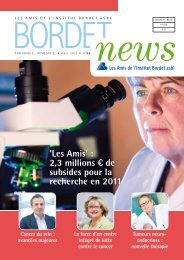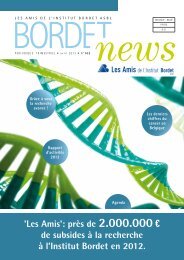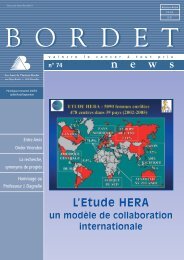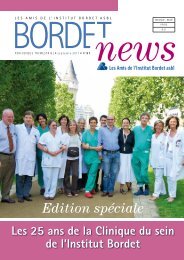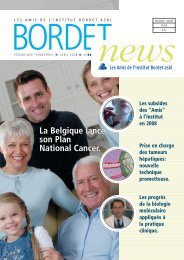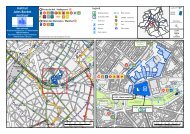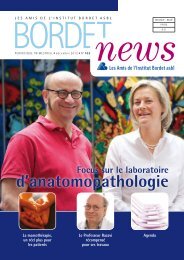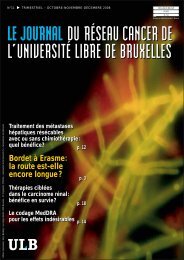Cancers familiaux et cancers héréditaires - Institut Jules Bordet ...
Cancers familiaux et cancers héréditaires - Institut Jules Bordet ...
Cancers familiaux et cancers héréditaires - Institut Jules Bordet ...
Create successful ePaper yourself
Turn your PDF publications into a flip-book with our unique Google optimized e-Paper software.
RECHERCHEGene expression profiling ofhistological grade in breast cancerchallenges the existence and clinicalrelevance of an intermediate gradeChristos Sotiriou, Micro Array Unit, <strong>Institut</strong> <strong>Jules</strong> Bord<strong>et</strong>christos.sotiriou@bord<strong>et</strong>.beDans ce travail, Christos Sotiriou identifie 97 gènes associés à des différences entre lestumeurs histologiquement gradées 1 ou 3. Il démontre que le grade 2 histologique sedivise, d’une manière tout à fait claire, en grade génomique 1 ou 3 qui ont le même pronosticvital que les grades histologiques correspondant 1 <strong>et</strong> 3. Le grade 2 histologiquen’est pas une entité distincte. C<strong>et</strong>te découverte aidera probablement à traiter plusefficacement les patients sur base de leur grade génomique.Histological grading (HG) of breast carcinomashas long been recognized toprovide prognostic information. However,despite recommendations by the Collegeof American Pathologists for use of tumorgrade as a prognostic factor, the latest BreastTask Force serving the American Joint Committeeon Cancer (AJCC) did not include itin its staging criteria, citing inconsistenciesb<strong>et</strong>ween institutions and lack of data. Forclinicians, knowledge of histological grade(HG) may significantly influence treatmentdecision-making, especially for small invasiv<strong>et</strong>umors. Nevertheless, whilst grade 1 (low risk)and 3 (high risk) are clearly associated withdiam<strong>et</strong>ric clinical outcomes, the prognosisof tumors classified as intermediate grade(or grade 2) is less clear. Furthermore, theirproportion is the largest (40%-60%), despit<strong>et</strong>he advent of standardized m<strong>et</strong>hods andeven when grading has been performed ina central laboratory by a single pathologist.Our recent study explored the possible contributionof gene expression profiling to theimprovement of the subtyping of tumorsaccording to biological grade. We showedthat the expression of a panel of genes canbe used to define a “gene-expression gradeindex” (GGi). Specifically, we were able todefine a two class “genomic grade” (GG) thatimproves the association b<strong>et</strong>ween gradeand outcome, in particular by effectivelyrecognizing tumors with very differentrisks of relapse among the HG2 population,while strongly agreeing with HG in theHG1 and HG3 populations. This improvedthe overall association b<strong>et</strong>ween grade andsurvival significantly.Using Affym<strong>et</strong>rix U133A Genechips, wegenerated expression profiles for 193 primaryoperable invasive breast cancer patients. Asubs<strong>et</strong> of 64 was used exclusively for selectinggenes significantly associated with differencesb<strong>et</strong>ween the 33 tumors that hadbeen classified by the local pathologist ashistological grade 1 and the 31 as grade 3.Statistical analysis revealed a group of genesthe expression of which was very stronglyassociated with grade. We obtained 128Affym<strong>et</strong>rix probe s<strong>et</strong>s corresponding to 97unique genes using a conservative selectionthreshold, so likely none was a false positive.The expression of these genes is fairlyhomogenous, as can be seen in Figure 1.The majority of these genes are overexpressedin grade 3 and in many cases theirfunction has been previously associatedwith cell cycle progression and proliferation(in the top 20 there are, for exampleUBE2C, KPNA2 TPX2, FOXM1, STK6, CCNA2,BIRC5 and MYBL2). We also applied thesame gene selection algorithm to contrastHG2 with HG1 with HG3 or the pool of HG1and HG3 tumors, respectively. We foundno evidence that the HG2 population as awhole has unique characteristics of its ownthat were independent of the describedgradient of expression existing b<strong>et</strong>weenHG1 and HG3. (Fig. 1)This observation above led us to test, wh<strong>et</strong>herhistological grade 2 could be replaced bylow and high grade based on gene expression.For this purpose, we used breast <strong>cancers</strong>amples derived from a pool of our ownpatients and additional published datas<strong>et</strong>stotaling over 650 tumor samples. Using theGGi, patients were classified as GG1 (lowgrade) if their GGi values were negative oras GG3 (high grade) otherwise. In figure 2,we then examined the association b<strong>et</strong>weenhistological grade, genomic grade andrelapse-free survival (RFS). As expected,HG3 tumors had significantly worse RFSthan HG1 while HG2 tumors had an intermediaterisk and constituted 38% of thepopulation (fig. 2a). To examine how thisdiscordance b<strong>et</strong>ween GG and HG wasrelated to prognosis, we looked in d<strong>et</strong>ail athow GG splits each of the histological categories.The most striking result was thatGG split HG2 into two groups with expressionpatterns similar to either HG1 or HG3tumors, called HG2/GG1 and HG2/ GG3respectively, and for which the RFS were alsosimilar to those of HG1 and HG3 respectively(fig. 2b). This lends support to theremarkable possibility of a two-categorygrading system in which all tumors areclassified as either low or high grade, butwithout any “contamination” of the risklevels of the traditional HG1 and HG3classes (fig. 2).“We found no evidence thatthe HG2 population as a wholehas unique characteristics ofits own that were independentof the described gradient ofexpression existing b<strong>et</strong>weenHG1 and HG3”In summary, our study has investigatedgene expression profiles and their associationwith HG. The two category gradingsystem proposed in this study may haveimportant clinical applications in the futurefor the prognostic assessment of breastcancer.■RéférencesSotiriou <strong>et</strong> al., Proc Am Soc Clin Oncol,Vol. 23:5s, 2005, abstract 506, paper submittedfor publication.22 JOURNAL DU RÉSEAU CANCER DE L’UNIVERSITÉ LIBRE DE BRUXELLES N°3 – SEPTEMBRE 2005ABORDET-IRIS — ERASME — WLLONIE — RESEAU CANCER


